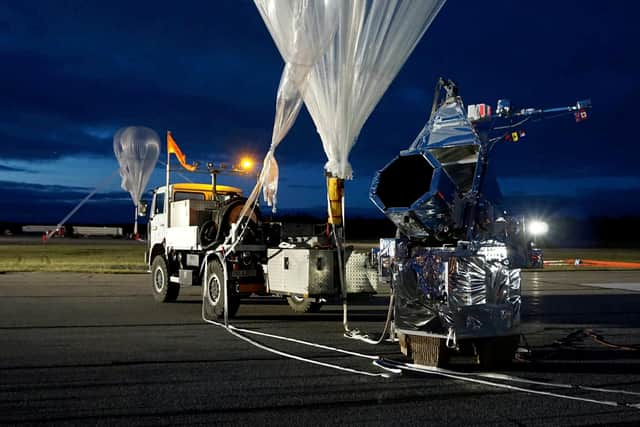SuperBIT: Massive balloon the size of a football stadium to launch telescope to edge of space
and live on Freeview channel 276
It will carry a wide field telescope that will rival Hubble - at a fraction of the cost, say British scientists behind the ambitious project.
The instrument, named SuperBIT, will fly above 99.5% of Earth s atmosphere next April.
Advertisement
Hide AdAdvertisement
Hide AdIt will study dark matter, the invisible 'glue' that makes up roughly 80% of the mass of the universe.


Astronomers map it by the way it bends rays of light, a technique known as gravitational lensing.
Professor Richard Massey, of Durham University, said: "Cavemen could smash rocks together, to see what they are made of.
"We are going to use SuperBIT to look for the crunch of dark matter. It is the same experiment - you just need a space telescope to see it."
A cheaper alternative to Hubble


Advertisement
Hide AdAdvertisement
Hide AdIt cost £1.5 million to build - compared to the £3.6 billion for NASA' s Hubble.
The international team are confident SuperBIT's (Superpressure Balloon-borne Imaging Telescope's) high-resolution images will be just as good.
It will test whether dark matter slows down during collisions. No particle colliders on Earth can accelerate dark matter.
But this is a key signature predicted by theories that might explain recent observations of weirdly behaving sub atomic particles called muons.
Advertisement
Hide AdAdvertisement
Hide AdLight from a distant galaxy can travel for billions of years before reaching our telescopes.
In the final fraction of a second, it has to pass through Earth's swirling, turbulent atmosphere - and our view of the universe becomes blurred.
Observatories on the ground are built at high altitude sites to overcome some of this.
But only placing a telescope in space fully escapes the effect. SuperBIT changes that.
How SuperBIT works
Advertisement
Hide AdAdvertisement
Hide AdIt has a mirror half a metre in diameter (1ft 8in) and is carried to an altitude of almost 25 miles (40km) by the huge helium balloon.
The mission will also be much less expensive than a typical machine-based alternative - and doesn't take as long to plan.
A final test flight in 2019 demonstrated the telescope's extraordinary pointing stability.
It was sufficient to thread a needle 0.62 miles (1km) away and hold it for an hour. It will enable images as sharp as those from Hubble.
Advertisement
Hide AdAdvertisement
Hide AdThe feat has never been achieved because it is incredibly difficult and balloons could only stay aloft for a few nights - too short for an ambitious experiment.
But NASA recently developed 'superpressure' balloons that can contain helium for months.
No instrument has revealed more about the heavens than Hubble. But SuperBIT could be "even better", according to the researchers.
It will take off from Wanaka on New Zealand's South Island - carried on the balloon by seasonally stable winds.
Advertisement
Hide AdAdvertisement
Hide AdIt will circumnavigate the Earth several times - imaging the sky all night, then using solar panels to recharge its batteries during the day.
SuperBIT is a collaboration between Durham, NASA, the Canadian Space Agency and Toronto and Princeton universities in Canada and the US.
It was unveiled at a virtual Royal Astronomical Society meeting.
Comment Guidelines
National World encourages reader discussion on our stories. User feedback, insights and back-and-forth exchanges add a rich layer of context to reporting. Please review our Community Guidelines before commenting.